
|
|
|
|
|
|
Classic Bikes
Custom Bikes
Individual
Racing Bikes AJP
AJS
Aprilia
Ariel
Avinton / Wakan
Bajaj
Benelli
Beta
Bimota
BMW
Brough Superior
BRP Cam-Am
BSA
Buell / EBR
Bultaco
Cagiva
Campagna
CCM
CF Moto
Combat Motors
Derbi
Deus
Ducati
Excelsior
GASGAS
Ghezzi Brian
Gilera
GIMA
Harley Davidson
Hero
Highland
Honda
Horex
Husaberg
Husqvarna
Hyosung
Indian
Jawa
Kawasaki
KTM
KYMCO
Laverda
Lazareth
Magni
Maico
Mash
Matchless
Mondial
Moto Guzzi
Moto Morini
MV Agusta
MZ / MuZ
NCR
Norton
NSU
Paton
Peugeot
Piaggio
Revival Cycles
Roland Sands
Royal Enfield
Sachs
Sherco
Sunbeam
Suzuki
SWM
SYM
Triumph
TVS
Ural
Velocette
Vespa
Victory
Vincent
VOR
Voxan
Vyrus
Walt Siegl
Walz
Wrenchmonkees
Wunderlich
XTR / Radical
Yamaha
Zero
Video
Technical
Complete Manufacturer List
|
Honda XR 500
|
| . |
|
Make Model |
Honda XR 500 |
|
Year |
1980 |
|
Engine |
Four stroke, single cylinder, SOHC, 4 valve |
|
Capacity |
497 cc / 30.3 cu-in |
| Bore x Stroke | 89 x 80 mm |
|
Cooling System |
Air cooled |
| Compression Ratio | 8.6:1 |
|
Induction |
Single 34 mm / 1.34 in piston valve Keihin carburetor |
|
Ignition |
CDI |
| Starting |
Kick |
|
Max Power |
36 hp / 26.3 kW @ 6500 rpm |
|
Max Torque |
41.4 Nm / 4.2 kgf-m / 30 lb-ft @ 5500 rpm |
| Clutch | Wet plate |
|
Transmission |
5 Speed |
| Final Drive | Chain |
| Frame | Welded tubular |
|
Front Suspension |
37 mm Showa forks |
| Front Wheel Travel | 224 mm / 8.8 in |
|
Rear Suspension |
Dual shocks |
| Rear Wheel Travel | 198 mm / 7.8 in |
|
Front Brakes |
140 mm drum |
|
Rear Brakes |
130 mm drum |
|
Front Tyre |
3.00-21 |
|
Rear Tyre |
4.10-17 |
| Dimensions |
Height 1215 mm / 47.8 in |
| Wheelbase | 1400 mm / 55.1 in |
| Seat Height | 880 mm / 34.6 in |
| Ground Clearance | 280 mm / 11.0 in |
|
Dry Weight |
123.0 kg / 271.2 lbs |
|
Wet Weight |
137 kg / 302.0 lbs |
|
Fuel Capacity |
12 Litres / 3.1 US gal |
|
Top Speed |
148.5 km/h / 92.2 mph |
|
Road Test |
Cycle World |
| . |
Road Test
WE'RE REALLY ROLLING NOW. SINCE 1976 each of the lour major Japanese motorcycle manufacturers has introduced at least one four-stroke dirt or dual-purpose bike. There are currently six basic four-stroke singles available, and counting variants there are 11 thumpers total on the market.
You need to know two things about those 11 machines. 1) The new XR500 is the best of the bunch. 2) Do not for a moment think that being the best compared to the other four-strokes means that it is truly competitive in relation to the best two-stroke enduro bikes. That second statement is not an irrelevant comparison, because Honda offers the XR as "enduro-ready." Consequently, the XR's performance must be compared both to other four-strokes—with which it has the most in common—and to other open-class enduro machines—against which it competes.
Honda Motor Co. took advantage of their experience with the XL250 to develop the XR500. In fact, the 500's basic engine, chassis and suspension designs are nearly identical to the 250's. However, Honda spokesmen are quick to point out that the 500 is not merely a bored and stroked 250; they use similar designs, but the big bike has beefier parts throughout to handle the extra power and weight.
As with the quarter-liter machine, the 500's mainshaft-mounted engine counterbalances are keys to the bike*s entire design. Honda R&D men believe the balancing system effectively quells the big single's inherent vibration; consequently the lower stresses allow the use of more delicate engine and frame components. Since excess weight is any four-stroke's major handicap, any design which results in less weight is of primary significance.
Regardless of Honda's intentions in designing the balancer system, its use has these real-life results. First, the balancers genuinely reduce vibration. There is no high-frequency vibration apparent at any time; though there's some noticeable low-frequency thumping, it's just there and it's not irritating at all. The XR is smoother than the Yamaha TT500, which simply uses extensive rubber mounting to absorb vibration; it's also smoother than the smaller Suzuki DR370, which uses no balancing system.
Next, it is perfectly logical that the 500's minimal vibration persuaded the designers to cut the weight of stressed parts in the engine and chassis; they knew they would not be sacrificing reliability. However, there's a Catch-22 snag in the balancing system. It weighs several pounds, and the XR itself, full of gas. weighs 293 pounds—exactly the same as last year's Yamaha TT500. Apparently the counter-balancers saved exactly enough weight in other places to offset the amount added. In the end, its major and only real benefit is to make the XR extremely smooth, and that alone is praiseworthy.
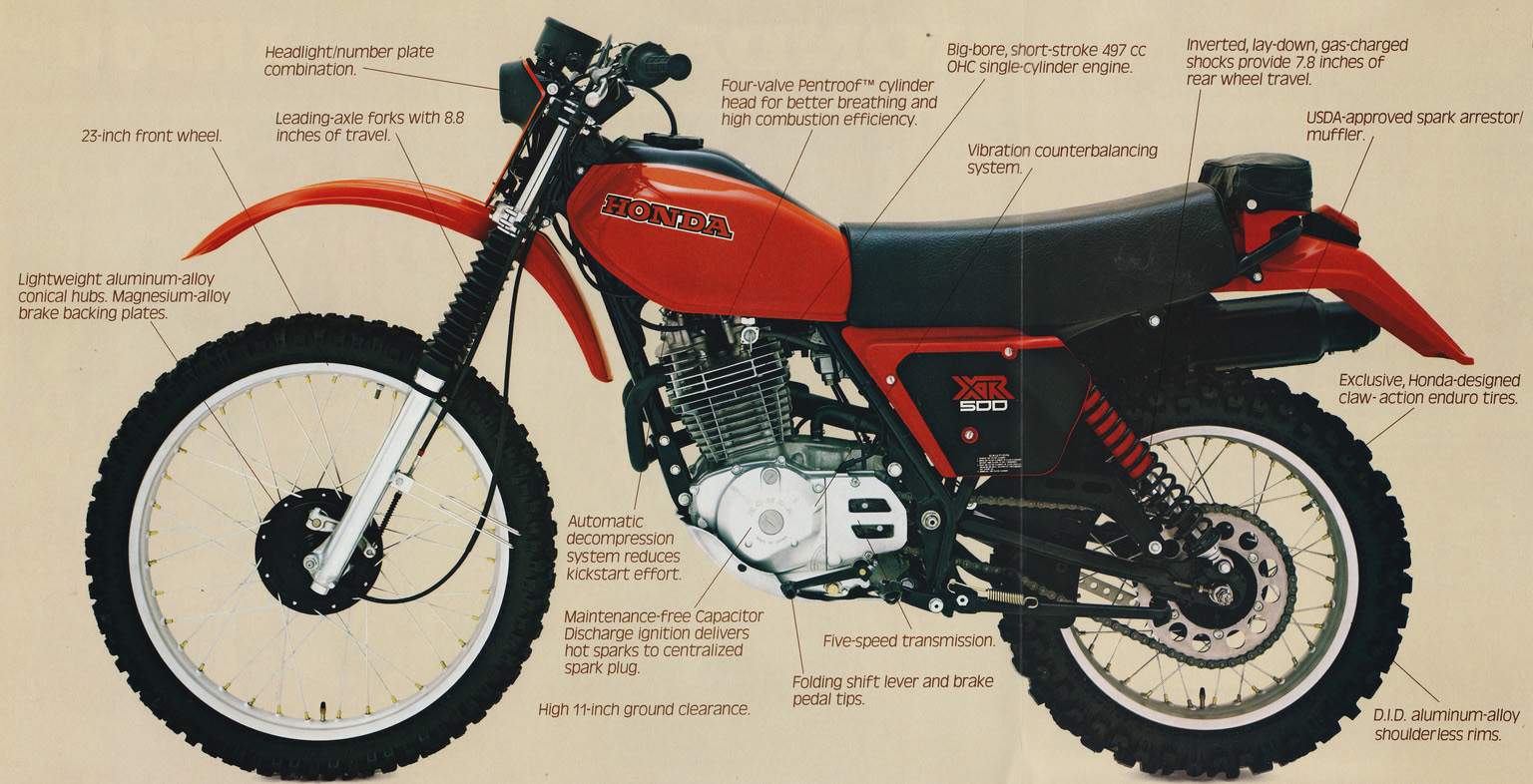
Technoids are probably wondering exactly how the balancer works and why it is significant that the alt balancer mounts on the mainshaft. The system's purpose, naturally, is to offset vibration produced by piston movement. The balancing mechanism consists of two bobweighls mounted on different shafts: each shaft is chain-driven by the crankshaft in the opposite direction ot the crankshaft. As the piston downstrokes, the crank turns the heavy sides of the balancing weights upward. When the piston reaches bottom dead center, the weights have turned 180 degrees from the big-end. Without the balancers to produce an equal and opposite reaction to the piston's movement, the pistons action results in vibration.
Honda has kept (he system as simple and light as possible and has made if
feasible to use on a dirt bike by mounting
the rear bobweight on the transmission mainshaft. Ordinarily, a balancing
system's two shafts have onty one function: to mount the weights. Two shafts
result m an unacceptable amount of extra weight in a din bike. Honda has at
least broken even in the weight department and reaped the benefit of outstanding
engine smoothness by eliminating the need for a separate aft counterbaiancer
shaft.
Though the 500 s balancing system's design is identical to the 250's. there are two main differences between the assemblies. First, the front balancer in the 500 is heavier and larger: 31 mm instead of 19mm. Second, the gears which turn the roller chain are coil-spring-damped to cope with the extra power of the big single; the 250's are rubber-cushioned.
In other respects the engine differs in detail rather than in design. The piston, of course, is larger. Though the 250 uses a high-dome piston for maximum compression (9.0:1). the 500 uses a flat-dome design for a more mild 8.6:1 compression ratio. Following Honda tradition, the 500 uses a tour-valve head, a design with several benefits.
First, four small valves are usually lighter than two large ones; lighter reciprocating parts can be moved quicker than heavier ones. Consequently, a four-valve engine can rev higher, pump greater quantities ot air and fuel in and out and thus make more power. Next, two exhaust valves allow the use of two small header pipes which can bend quickly and thus make room for the large 23-inch front wheel. Finally, two exhaust valves permit an air passage to run from the front of the engine and up to the top of the head, and this passageway provides better cooling.
In more and more of their machines. Honda has begun to use Hy-Vo-type cam chains which have proven stronger and quieter than standard roller chains. The XR500 has a Hy-Vo chain, The camshaft turns directly on the metal of the cylinder head, a method which has proven reliable so long as adequate oil pressure is maintained. It's lighter and less expensive than a ball- or roller-bearing assembly, and damage to the camshaft journals or to the cylinder head is a danger only in the complete absence of oil. Even when an engine is first started—when most of the oil is in the sump—there is enough residual oil in the top end to provide adequate lubrication until fresh oil arrives.
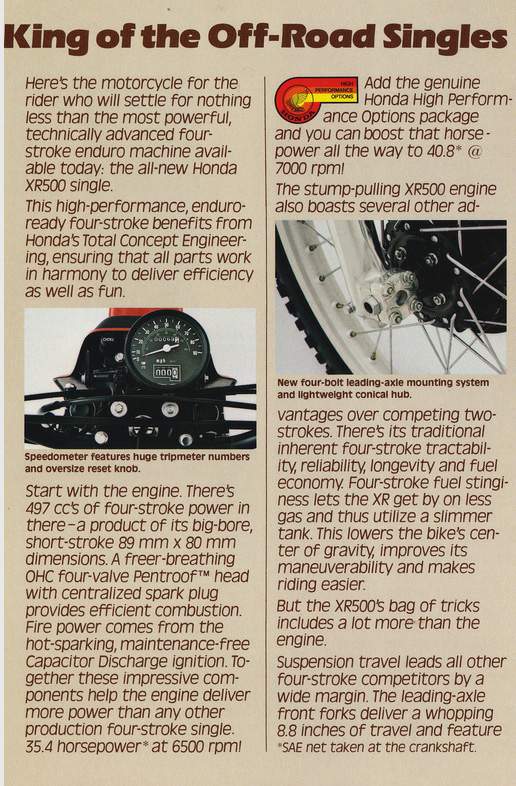
The powerplant's lower end differs from the 250's in several ways. Though the
gear material is the same as in the smaller bike, the duration of the hardening
process is lengthened to produce stronger gears. All the gears differ in number
of teeth to lower all the gear ratios for higher speeds. The primary gear ratio
is identical to the 250s. but the crank gear has been increased in width from
12mm to 15mm. To handle the big bike's extra torque, the 500 uses a seven-plate
dutch rather than the 250s four-plater
Finally, the trochoidal pump has been increased in diameter from 13mm to 15mm to
pump about 15 per cent more oil through the larger wet-sump engine.
All of the other "Features" on the XR are functional, and some are even unique.
The mechanically activated exhaust-valve lifter facilitates starting. When the
kick lever is depressed, it operates a cable which opens the exhaust valves,
making the engine easy to kick through the compression stroke. The kick lever
ratchets over the cable actuater and lets the valves close as the lever passes
through about one third of its stroke. Capacitor-discharge ignition eliminates
the fuss of points maintenance, and a mechanical advance retards the timing,
relieving the
potential for a terrific kickback.
Both the intake and exhaust systems of the XR are fairly standard. Street-legal
XL Hondas have carburetors with accelerator pumps.
These pumps supply extra fuel in the low- and mid-range when the throttle is suddenly opened The XLs need extra gas in such circumstances because Honda has chosen to meet emissions standards by leaning out the bottom end of the carburetion. Since the XRs, as dirt bikes, are not so stnctly regulated, their carbs have sufficiently rich low-end jetting and do not need accelerator pumps. A large dual-header pipe with a spark arrestor and muffler effectively quiets the Honda's roar, weighs a ton and tucks in unobtrusively.
When the rider clicks the XR into gear, he feels the 500 accelerate smoothly right from idle. In light of Honda's fondness for high-rewing engines, it « not surprising that the XR quickly builds power into the high rpm range One does not ordinarily want to keep a btg four-stroke single spinning hard because of the vibration, but the XR is controllable and offers its best power up high. But this doesn't mean the Honda is lacking in tow-end power; check these figures out. The XR develops 11.82 horsepower and 24.82 pounds/feet of torque at 2500 rpm—barely above idle. At 3500 rpm it's producing 17 horsepower and 26 lbs/ft of torque, compared to 13 horsepower and 19 lbs/ft of torque developed by last years Yamaha TT500. While the XR makes its best power at 6500 rpm (33.44 horsepower), it doesn't penalize overrewing, continuing to produce nearly 27 horsepower up until 8500 rpm. This powerband is superb: it lets the rider power out of tight situations, chug up hills effortlessly and relax while he trail rides There is also a predictable but abundant surge of power m the mid-range, at which point it's incredibly easy to wheelie the machine in the first three gears. Thanks to its smooth powerband. riding the Honda is above all tun.

Even though the engine is smooth and makes the XR enjoyable to ride, its power delivery to the rear wheel is jerky: there is a disconcerting amount of gearbox-generated backlash. It's a common practice to use large gear engagement slots-giving the dogs a large target, so to speak—to help prevent missed shifts. To this end the design succeeds: the Honda never misses a shift. The drawback is that the dogs, once engaged, can move back and forth in the engagement slots. When the dogs first enter the slots there is a clunk, and the gears resist fluid engagement when the clutch is not used; luckily, clutch actuation is progressive and fade-free. Every time the engine is accelerated or decelerated, though, the engaging dogs rush from one end of their matching slots to the other end; this condition is known as backlash.
This sloppiness is especially noticeable in a big four-stroke single where it combines with the normal but abundant engine-braking effect. In a dirt bike, backlash alone is not usualfy a legitimate complaint, because loose rear-wheel traction disguises it. But occasionally at low speeds, and particularly at low rpm in the bottom gears when there is not enough inertia being generated to keep the running gear moving, me backlash and engine compression combine to lock the rear wheel momentarily and kill the engine. Unfortunately, the rider most often uses low-rpm power in tight trail conditions when he can least afford to stall the bike.
A rider can work around the problem and get power to the ground perfectly smoothly by running the engine in the mid- to high-rpm range, but this practice should not be necessary: the primary reason for buying a big four-stroke is to enjoy its low-end slogging power.
One of the more pleasant aspects of the Honda is its range on a gallon of gas. Under any condition—fireroad cruising, full throttle in sand or winding along mountain trails—it consistently averages 30 miles per gallon. With its 2.6-gallon fuel capacity, the 500 has a range of 78 miles, enough for very long enduro loops.
Like the engine, the XR chassis' basic design derives from the 250. The 500 has greater frame-wall thickness for more strength and weighs 23.54 pounds compared to the 250s 20.24 pounds. Both frames are mild-steel units with bushing-mounted swing arms, and use the engine as stressed members.

Several features of the XR chassis combine to give the XR very unusual handling characteristics. Honda is still the only manufacturer offering a 23-inch front wheel, and the XR uses it. As many designers have discovered, the large wheel necessitates many other changes. Honda has given the XR a rather steep 28.5-degree head angle, a rather long 138mm (5.4-inch) trail and a rather short 1400mm (55.1-inch) wheelbase.
Through tight twisty terrain the XR steers precisely and quickly; despite its steep rake it offers neutral steering response when traction is maintained. When the rider slides the XR, however, the bike understeersa lot. tending to straighten out of the slide early and follow the direction of the 23-incher The bike must be leaned over farther than is typically necessary to keep a bike sliding, probably a result of the front wheel's larger contact area. The XR, moreover, can be thrown into a very deep slide under complete control. It is a unique feeling and certainly stems from combining a short wheelbase and steep head angle (which ought to result in oversteer and easy sliding) with a large front wheel.
In the area of suspension Honda has chosen to cut corners. The leading-axle fork is an oil-spring unit which allows 223mm (8.8 inches) of travel when the rebound spring is fully compressed. In addition. 35mm fork tubes are used, which compare unfavorably with the typical 36 to 38mm items found on the competition. The gas-charged shocks, with adjustable preload and single-rate springs, are long 17-inch units, and they are basically the same in design as the CR250R shocks. In very rough terrain the fork has just a hint of flexing.
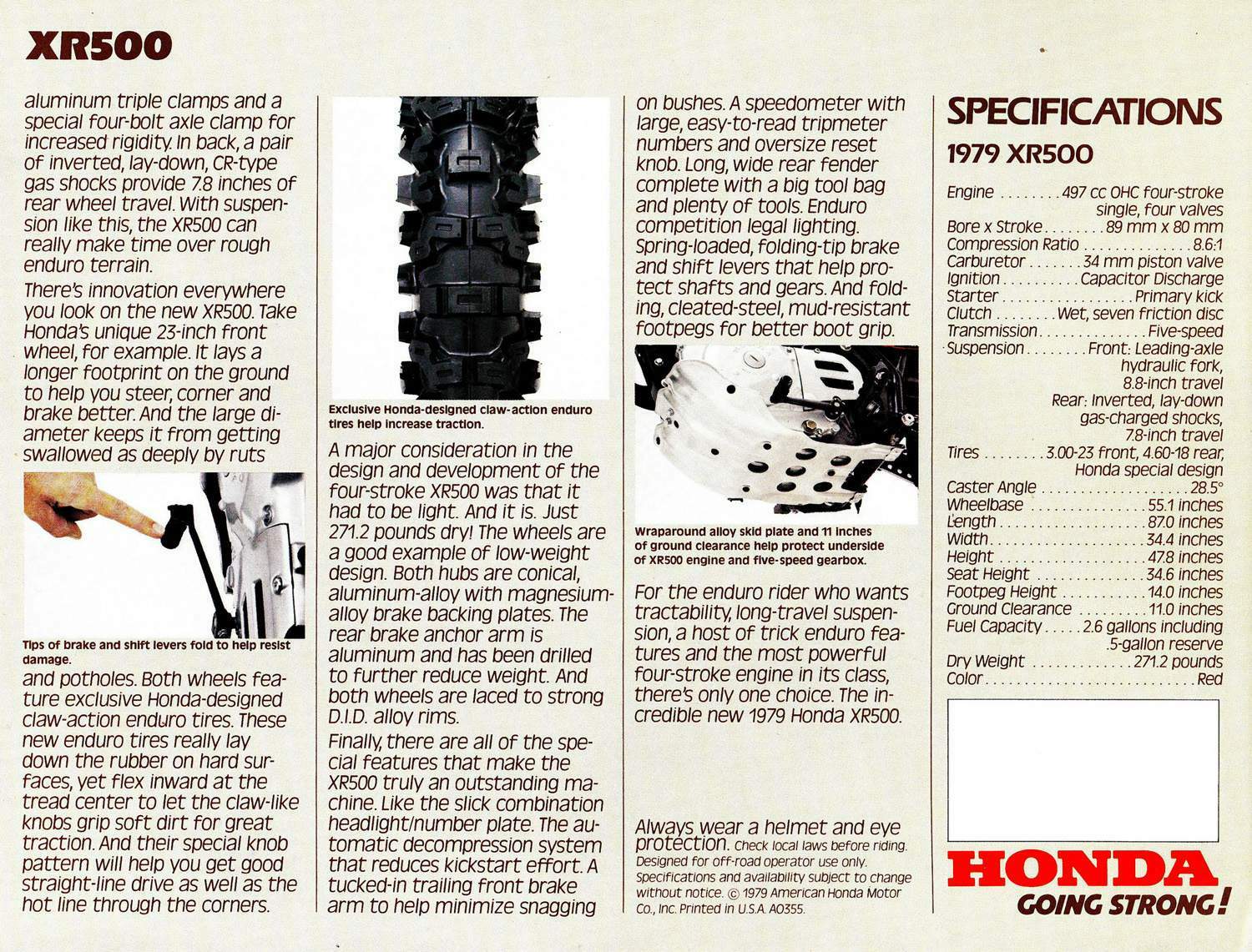
There is also a modest amount ot stiction, an initial resistance to compression over small or smooth bumps. In moderately rough areas the fork works well, soaking up medium-size bumps with smooth damping action and a spring rate which provides a comfortable ride lor 170-pound riders. Over very sharp bumps the fork bottoms frequently, though, and this inhibits the rider from making serious high-speed runs over rough ground.
Similarly, the shocks bottom often over rough ground, but on typical woods or cross-country trails they work fine. It is most important to point out that even though the suspension uses its travel quickly, the Dike never gets out of control; through whoops and even in rough ground when the suspension has bottomed, the XR does not side-hop. The bike's weight is noticeable, but it's easy for the rider to discover the bike's limits and then ride right to them without fear of the bike suddenly turning nasty.
Durable six-ply knobbies are standard on the XR Because they are heavy-duty tires and can withstand some punishment, a couple of options are available when selecting tire pressure. Running 12 to 14 pounds of air pressure smooths out the ride considerably and lets the owner stiffen up the suspension to help prevent bottoming; using a bit more air protects the rims from rocks.
The patented claw-action tires work very well on hard Surfaces; they are
excellent on fireroads and on typical mountain trails which are a mixture of
rocks, loam and leaves. But they steadily deteriorate in performance as the
ground gets softer, and they are marginal performers at best in sand.
Both brakes on the Honda are powerful and progressive. The front unit is
excellent; the rear's action occasionally becomes grabby. especially when being
applied over bumps.
A long, soft seat feels too comfortable to be true. The foam compresses quickly, though, and wherever the rider sits in the first few hours of riding becomes His Spot. Because the foam is deepest at the front of the seat, and that's where the average-sized rider sits, it's normal (or a pocket to form there. Despite the compressing of the foam and the fact that the rider is more or less confined to one position, the seat remains comfortable even for hours-long rides.
Source Cycle magazine 1979
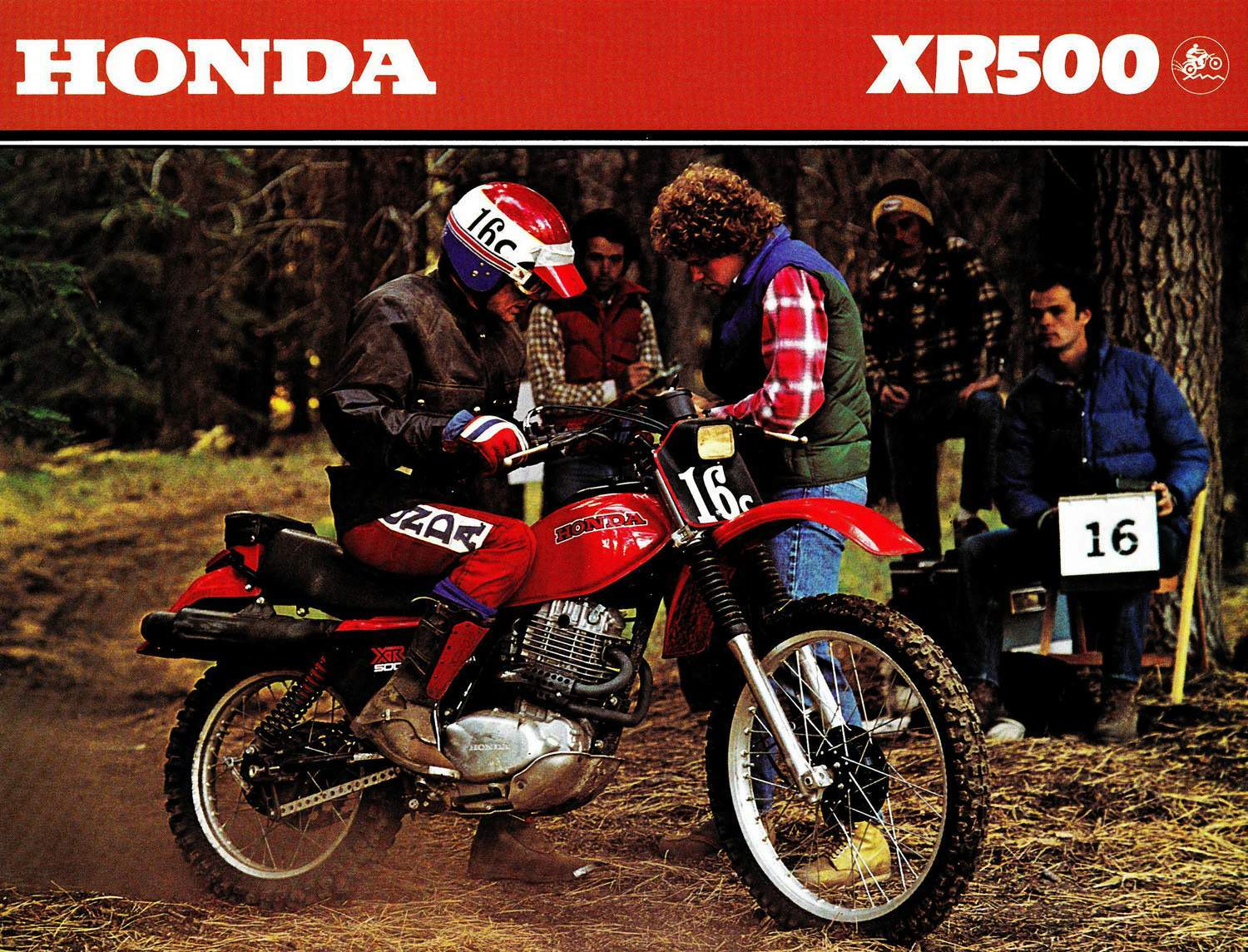
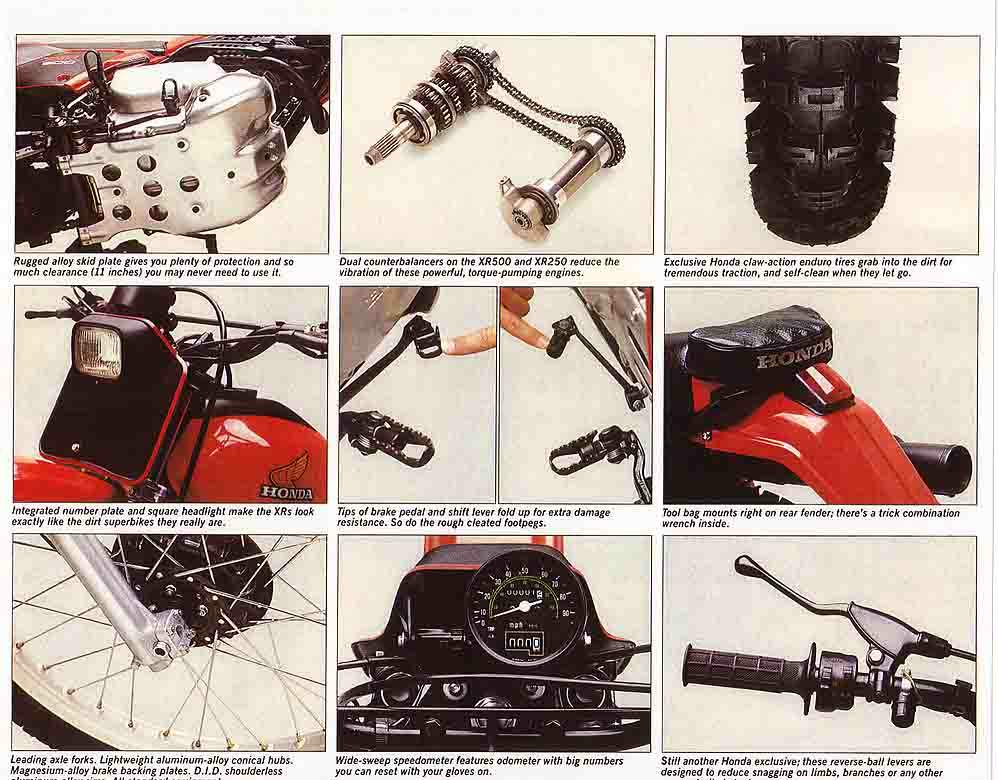
|
Any corrections or more information on these motorcycles will be kindly appreciated. |